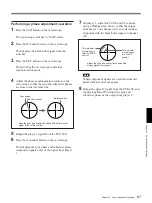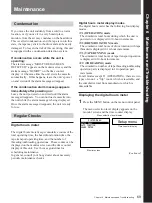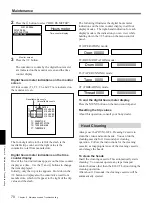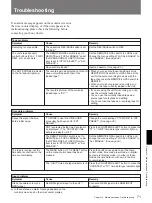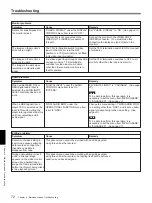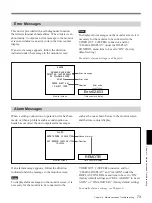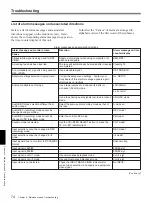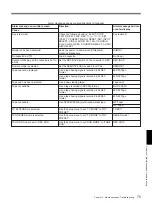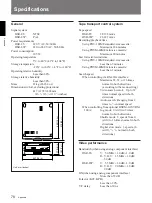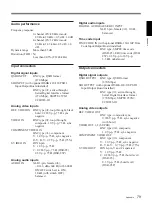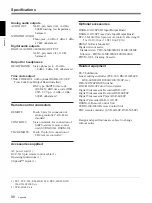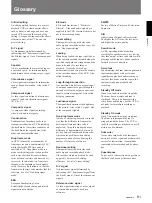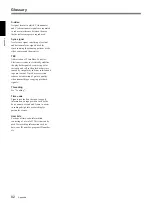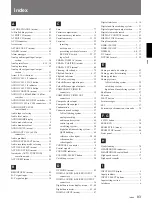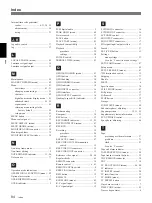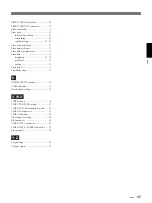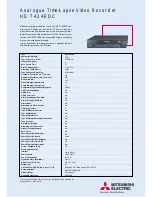
Appendix
Appendix
81
Glossary
A/B roll editing
An editing method that uses two or more
playback VCRs to create special effects
such as dissolve and wipe, and uses one
record VCR to record the results of the
editing. Using an editing controller allows
efficient control of the VCRs and very
precise editing.
B–Y signal
A chrominance signal determined by
subtracting the Y (luminance) signal from
the B (blue) signal. One of the component
signals.
Capstan
A drive mechanism that moves the tape at
a specified speed. Its rotation normally
synchronizes with a reference sync signal.
Chrominance signal
Color signal containing color information
such as hue and saturation. Also called C
signal.
Component signal
A video signal consisting of a luminance
signal (Y) and two chrominance signals
(R–Y, B–Y).
Composite signal
A composite video signal containing
video, burst and sync signals.
Condensation
Condensation of moisture on the tape
transport mechanisms of VCRs including
the head drum. If moisture condenses on
the head drum, the tape adheres to the
drum and causes malfunction.
Drop frame mode
In NTSC format, the actual number of
frames per second is approximately 29.97,
while that for SMPTE time code is
specified as 30. Drop frame mode is a
mode in which time code is advanced in
such a way that the difference in frame
value between real time and time code is
corrected. In this mode, two frames are
skipped at the beginning of each minute,
except for every tenth minute, so that the
frame value for time code matches that for
real time. See also “Non-drop frame
mode”.
EBU
European Broadcasting Union.
Established by broadcasting and related
organizations in Europe.
EE mode
EE is an abbreviation of “Electric to
Electric”. Video and audio signals are
supplied to the VCR’s internal circuits, but
not to the recording heads.
Linear editing
Editing while playing back video and
audio signals recorded on video tape. See
also “Non-linear editing”.
Loading
When being loaded, the tape is pulled out
of the cassette case and threaded along the
specified tape path and wrapped round the
drum to be ready for recording or
playback. Generally, this is done
automatically when you place the cassette
at the cassette entrance of the VCR. Also
called threading.
Loop-through connection
A connection which allows a signal input
to an input connector to pass through the
unit and exit from an output connector as
input to external equipment. Also called
bridging connection.
Luminance signal
The signal that determines the brightness
of the picture. Also called Y signal. One
of the component signals.
Non-drop frame mode
A mode of advancing time code in such a
way that the difference in frame value
between real time and time code is
neglected. Using this mode produces a
difference of approximately 86 seconds
per day between real time and time code,
which causes problems when editing
programs in units of seconds using the
number of frames as a reference.
Non-linear editing
Editing while playing back video and
audio signals recorded on hard disks.
Video scenes stored on disk can be cued
up quickly, for increased editing
efficiency. See also “Linear editing”.
R–Y signal
A chrominance signal determined by
subtracting the Y (luminance) signal from
the R (red) signal. One of the component
signals.
Reference video signal
A video signal consisting of a sync signal
or sync and burst signals, used as a
reference.
SMPTE
Society of Motion Picture and Television
Engineers.
S/N
Abbreviation of Signal-to-Noise (ratio).
The higher the S/N value, the less noise
and higher the picture quality.
Search mode
A VCR operating mode used when
searching for specific scenes, by viewing
the video output or time code values while
playing back the tape at various speeds in
forward or reverse direction.
Servo lock
Synchronizing the drum rotation phase and
tape transport phase with a reference
signal during playback and recording so
that the video heads scan the tape in the
same pattern during playback and
recording.
Standby Off mode
One of two conditions in the stop mode.
The drum does not rotate and tape is
slackened. There is no damage to the
video heads and the tape, but the VCR is
not ready for immediate recording or
playback.
Standby On mode
One of two conditions in the stop mode.
The drum is rotating and the tape is
wrapped round the drum. The VCR is
ready for recording or playback, so a still
picture can be obtained.
Subcarrier
A sine wave imposed on the luminance
portion of a video signal and modulated to
carry color information. Its amplitude
represents color saturation and its phase,
hue.
Superimpose
To put a set of characters onto a picture so
that both can be seen at the same time.

